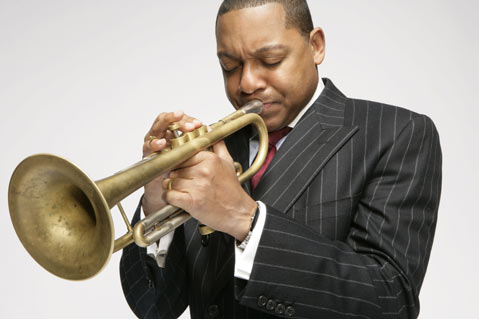The Jazz at Lincoln Center Orchestra Plays the Arlington
Clarinetist Ted Nash Talks About Composing for and Playing with Wynton Marsalis and the JLCO

This just in: Jazz is not dead. Evidence of its continued vitality can be found Sunday afternoon at the Arlington Theatre, when trumpeter Wynton Marsalis leads a performance by his Jazz at Lincoln Center Orchestra.
However, there have been reports of vultures circling the vibraphones.
In August, Terry Teachout, the Wall Street Journal‘s highly respected cultural critic, wrote an alarming column noting that jazz audiences-like their counterparts at classical concerts-are getting older. He warned that unless the music can find a way to appeal to younger listeners, it eventually will die out.
Saxophonist, clarinetist, composer, and arranger Ted Nash, a 12-year veteran of the Jazz at Lincoln Center Orchestra, is far from alarmed. But he isn’t complacent, either.
“I’ve noticed on our last tour or two that audiences are down a little bit,” he said in a telephone interview from his New York City home. “But I think that has more to do with the economy. If people have to cut back on something, they tend to do so on things like concert tickets-which is a shame, because that’s what colors our world and enriches our lives.”

In terms of reaching a new generation, “I see more and more young people at our concerts everywhere we go,” he insisted. “I think young people are starting to discover jazz. In the ’50s, college students felt jazz was kind of cool. It was a trendy thing. [But for today’s younger listeners], I think it goes deeper. People are recognizing the beauty of the music.”
Nash noted, “If you go into a coffee shop or hotel lobby, it’s no longer mood music they’re playing-it’s jazz. Now, I’ve asked myself whether that’s good or bad. If jazz becomes background music, that’s bad. But you are exposing people to this music, and they’re discovering that they like it.”
Santa Barbara certainly likes both Nash (who has performed with his own small ensemble at SOhO) and the Jazz at Lincoln Center Orchestra, which he joined in 1997. Thanks to UCSB’s Arts & Lectures, the virtuoso ensemble has performed in the area every other year or so since 2001. Unlike some past tours, the current one doesn’t have a theme, and there’s no way of knowing what specific pieces the musicians will perform at the Arlington.
“Before we go out on tour, Wynton will get together with the librarian in New York, choose between 50 and 100 pieces of music, and put them in the book. That will be the main library of music we carry with us on the tour,” Nash said. “Three hours before the concert, we’ll do a sound check, which lasts about 45 minutes. At the sound check, Wynton will grab one or two things we haven’t yet played on the tour and we’ll rehearse them. Then he’ll sit there at dinner between the sound check and the gig and make a decision, choosing seven or eight pieces per set. It changes every night, and Wynton does it on the spur of the moment.”
That said, there’s a very good chance Sunday’s program will include excerpts from Nash’s Portrait in Seven Shades, a jazz suite the orchestra premiered at its home base in Manhattan in 2007. A CD will be released in January.
“During my first couple of years in New York, I went to a lot of galleries and museums and learned so much about art,” he recalled. “Although I don’t go to museums as much today, I remember those feelings of being inspired by art, and I was able to draw on it to write this music.”
Like the incomparable Duke Ellington, Nash found himself writing passages with specific members of the band in mind. By focusing on their individual voices, he was able to retain a visceral, emotional connection to the music-something he feels is vital in an age of too much empty virtuosity.
“For people to like the music, it has to be honest, real, and engaging,” he said. “Back in the old days, there was a lot of urgency in jazz. It was a reflection of society. Jazz has become more intellectual now. It’s an art form. We have to recover that sense of urgency. If you talk to people who don’t like jazz, they’ll say, ‘It just seemed like you were playing a whole lot of notes that don’t make any sense.’ And at times, they’re right! I was playing with some jazz musicians the other day in New York, and they were just playing a lot of extra stuff that doesn’t need to be there. It’s a kind of showing off. You can lose an audience that way.”
Nash added, “This has nothing to do with selling out or making it more commercial. It means that we have to be fully involved in the music we’re playing and engaged with the musicians we’re playing with. That way, even if they don’t have a lot of background knowledge or understanding, the people who are listening to it will say, ‘Wow-there’s something happening here.'”
4•1•1
UCSB’s Arts & Lectures presents the Jazz at Lincoln Center Orchestra at 1 p.m. on Sunday, September 27, at the Arlington Theatre. Tickets are $38-$68; $23 for UCSB students. Call 893-3535 or visit artsandlectures.ucsb.edu for tickets and more information.



